Outlook (Windows)
When you no longer want to see messages from someone, you can block a sender.
Right-click a message from the sender you want to block, and then click Junk>Block Sender.
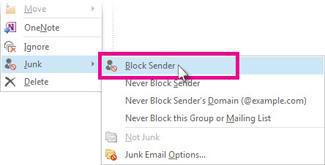
The blocked person can still send you mail, but if anything from his or her email address makes it to your email account, it’s immediately moved to the Junk Email folder. Future messages from this sender will go to your Junk Email folder.
It’s a good idea to periodically review email messages identified as junk to make sure you’re not missing important messages.
To add a specific sender to the Blocked Senders List, click a message from the sender. On the Home tab, in the Delete group, click Junk and then click Block Sender.
To add names to the Blocked Senders List:
-
- On the Home tab, in the Delete group, click Junk, and then click Junk E-mail Options.
- On the Blocked Senders tab, click Add.
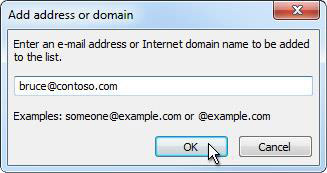
3. In the Enter an e-mail address or Internet domain name to be added to the list box, enter the name or address that you want to add. For example, you can add:
1. a specific email address, such as someone@example.com
2. an Internet domain, such as @example.com, or example.com.
4. Click OK and repeat for each entry that you want to add.
To add a person to the Safe Senders List, click a message from the sender. On the Home tab, in the Delete group, click Junk, and then click Never Block Sender.
To add a specific address or domain to the Safe Recipients List, click a message from the sender. On the Home tab, in the Delete group, click Junk, and then click Never Block the Group or Mailing List.
To manually add names or domains to these lists, do the following:
- On the Home tab, in the Delete group, click Junk, and then click Junk E-mail Options.
- Do one of the following:
- To add safe senders, on the Safe Senders tab, click Add.
- To add safe recipients, on the Safe Recipients tab, click Add.

- In the Enter an e-mail address or Internet domain name to be added to the list box, enter the name or address that you want to add. For example, you can add:
- a specific email address, such as someone@example.com
- an Internet domain, such as @example.com, or example.com.
- Click OK and repeat for each entry that you want to add.
- If you want all Contacts to be considered safe senders, select the Also trust e-mail from my Contacts check box in the Safe Senders tab.
- Some people whom you correspond to might not be listed in your Contacts. If you want all such people to be considered as safe senders, select the Automatically add people I e-mail to the Safe Senders List check box.
- If you have existing lists of safe names and addresses, you can move that information into Outlook. Click Import from File and browse for the list file that you want. To create a file that uses your current list, click Export to File and then specify where you want the new file saved.
- To change a name on either list, click the name that you want to change and then click Edit. To remove a name, click the name that you want and then click Remove.
- If you are using a Microsoft Exchange Server account, all of the names and email addresses that are in your organization's address book — also known as the Global Address List — are automatically considered safe.
- On the Home tab, in the Delete group, click Junk, and then click Junk E-mail Options.
- On the International tab, click Blocked Top-Level Domain List
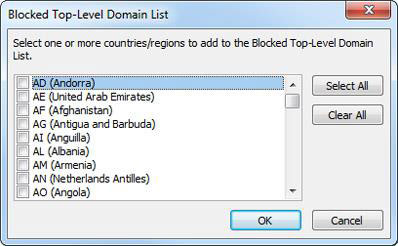
- In the list, select the check box for the country/region code that you want to block, or click Select All.
- Click OK in both open dialog boxes.
- On the Home tab, in the Delete group, click the arrow next to Junk, and then click Junk E-mail Options.
- On the International tab, click Blocked Encodings List.
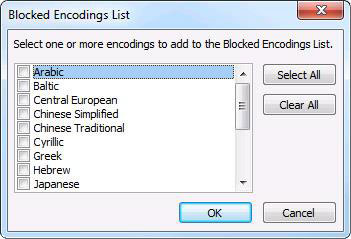
- In the list, click the language encoding that you want to block, or click Select All.
- Click OK in both open dialog boxes
In Microsoft Outlook, click Home > Junk > Junk E-mail Options
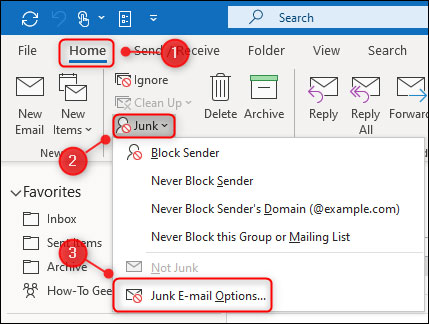
You’ll need to export Safe Senders and Blocked Senders separately. Open the “Safe Senders” tab and click “Export to File.”
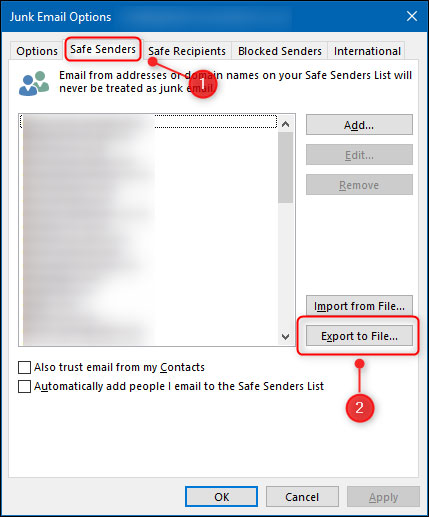
This will open a standard file dialogue for you to save the file somewhere on your computer. Choose a location, type a name for the file, and save it.
Now open the “Blocked Senders” tab and click “Export to File".
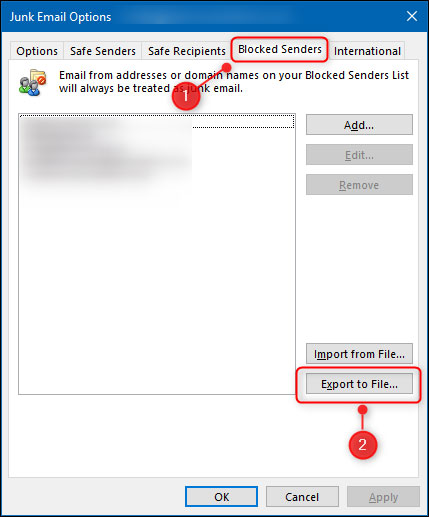
As with Safe Senders, this will open a standard file dialogue for you to save the file somewhere on your computer. Choose a location, a name for the file, and save it.
You should now have two TXT files that you can import into a new account or Microsoft Outlook that’s installed on a different computer.

Importing those files is as simple as exporting them. Head back to the Junk Email Options menu by clicking Home > Junk > Junk E-mail Options in the Microsoft Outlook desktop app. To import the Safe Senders file, open the “Safe Senders” tab and click “Import from File.”
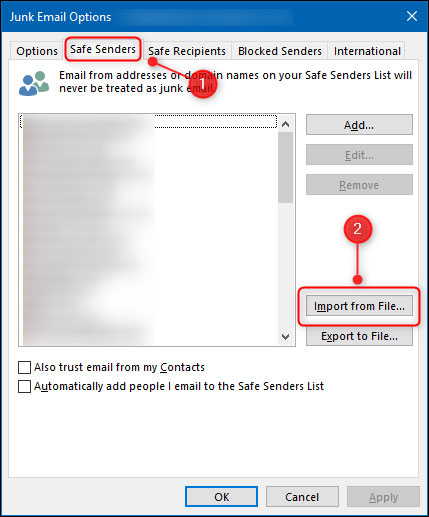
To import the Blocked Senders, open the “Blocked Senders” tab and click “Import from File.”
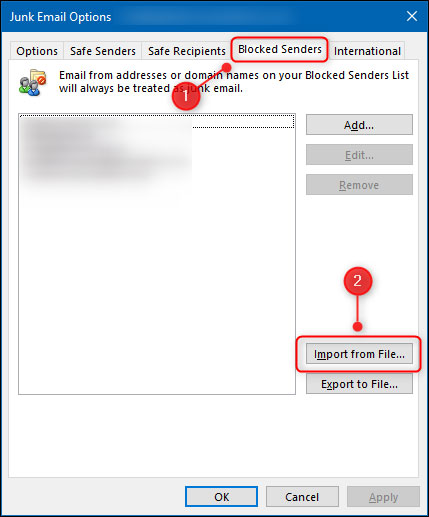
The import will add any senders to the existing lists, rather than overwrite the existing entries.






